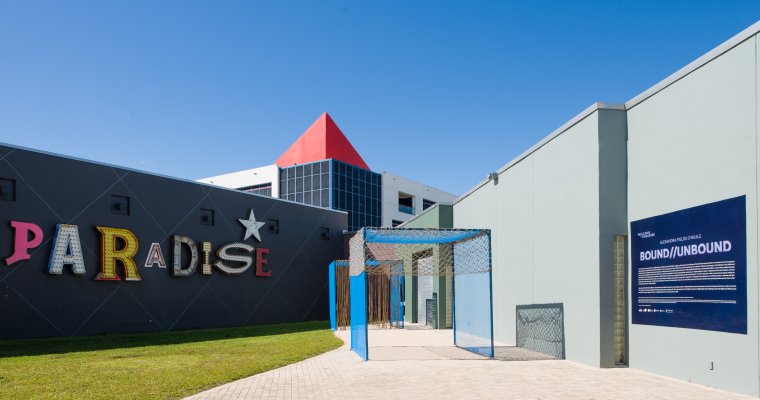
"Welcome to Paradise" is a new commissioning program featuring temporary public art projects by local South Florida artists. (Photo courtesy of MOCA)
Exploring the little-known Saltwater Railroad, or, the coastal waterway followed by many enslaved people escaping from the Southern slave states into the British-controlled Bahamas, is part of Miami artist Alexandra Fields O’Neale’s sound art installation, “Bound/Unbound,” in the courtyard of the Museum of Contemporary Art North Miami (MOCA), part of the Museum’s Welcome to Paradise series.
The Saltwater Railroad is the South Florida counterpart to the northern Underground Railroad, and according to the website Blackpast.org, the movement of enslaved American Blacks began in 1821 when future President Andrew Jackson invaded Spanish Florida and hundreds of Blacks fled to the Bahamas, beginning a four decades-long movement.
It’s estimated that by the 1830s, 6,000 enslaved people had escaped the U.S. to the islands.
“The installation is a two-part story,” says O’Neale, 34, who says she learned about this lost part of American history in the recent past. “The first part symbolizes the journey of enslavement to freedom through the Saltwater Railroad and the second part symbolizes the reverse journey – the journey of free Africans into enslavement in the trans-Atlantic slave trade.”
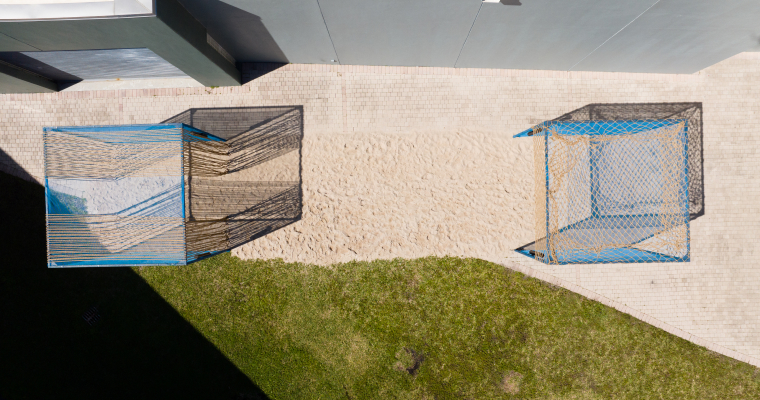
Alexandra Fields O'Neale's sound art installation, “Bound/Unbound,” in the courtyard of the Museum of Contemporary Art North Miami (MOCA), part of the Museum's Welcome to Paradise series. (Photo courtesy of MOCA)
O’Neale explores themes of Black identity, historical narratives and ancestral trauma through photography, video and sound art. For this project, she used an underwater microphone called a hydrophone to pick up the sounds of the ocean, sand and shoreline, then digitally manipulated the sounds to tell her story. She imagines the ocean as narrator, retelling the history of this city and honoring the ancestors who were its original inhabitants.
Curating sounds that were harsh and grating for the transition into slavery, she captured other lighter, more airy and optimistic sounds for the journey into freedom.
She admires the work of American photographer Carrie Mae Weems, known for her “Kitchen Table Series,” which explores themes of sexism, racism and identity. (“I’m in awe of her work.”), visual artist and printmaker Betye Saar, (“Her work blows me away.”) and Haitian-American artist Michelle Lisa Polissaint, a photographer and fiber artist (“She’s so inspiring.”).
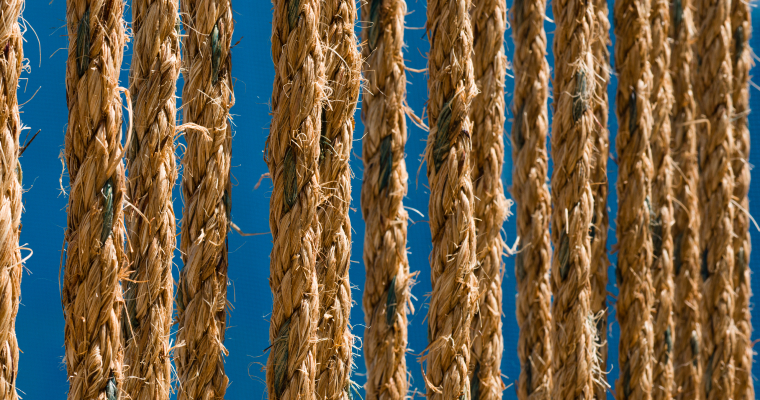
Alexandra Fields O'Neale explores themes of Black identity, historical narratives and ancestral trauma through much of her work. (Photo courtesy of MOCA)
O’Neale says she is grateful to MOCA for this opportunity to showcase her work and eager to see where it leads.
“I’m excited for the journey,” she says. “I’m constantly inspired and yearn to create. I’m fortunate that I can take time to focus on my work and go deeper creatively.”
MOCA’s curator Adeze Wilford says bringing new concepts and new media to the museum as well as showcasing local artists is part of the museum’s mission.
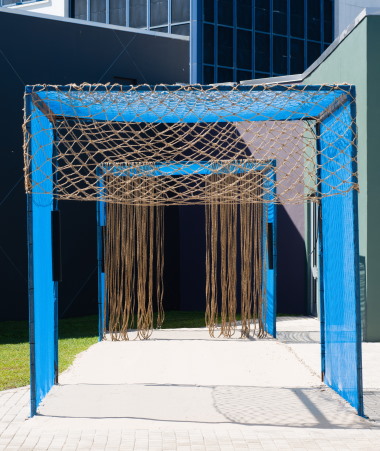
Alexandra Fields O'Neale's sound art installation, “Bound/Unbound,” in the courtyard of the Museum of Contemporary Art North Miami (MOCA). (Photo courtesy of MOCA)
“We are providing South Florida artists the opportunity to present ideas of history and culture in ways that are helping their art practice evolve,” she says. “We want to highlight the stories of Miami that are not part of the mainstream and add something new to the conversation.”
One of the new mediums is Miami-based sculptor Yanira Collado’s kinetic installation, “For those who transcend in the wind/En los Ritmos de Oya/Nan ritm yo Oya,” on the plaza - the first installation in the museum's three-part Art on The Plaza series.
The annual program, inaugurated in 2020, provides an opportunity for South Florida artists to engage with the museum and its community, employing MOCA’s front plaza as a platform to elevate their site-specific, temporary public art installations.
The other two exhibits will be Christopher Mitchell’s photographic series, “Haitian Mermaids” and Cuban-American artist Nicole Salcedo’s installation, “Earth Gate.”
“As part of our mission, we’re dedicated to showcasing the creative breadth and scholarship of Miami’s local artists while also providing opportunities for the community to access and engage with our city's vibrant arts scene,” says Chana Sheldon, MOCA executive director.
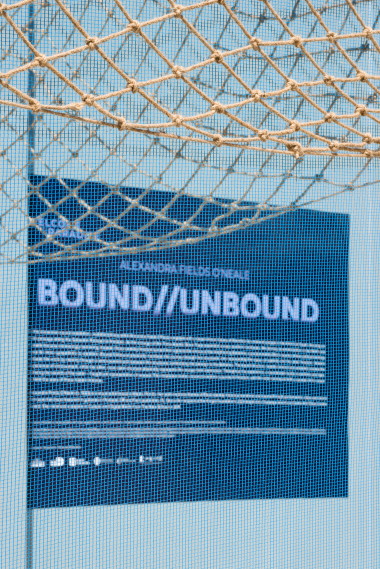
The title wall at Welcome to Paradise introduces Alexandra Fields O'Neale's installation, “Bound/Unbound” in the courtyard of the Museum of Contemporary Art North Miami (MOCA). (Photo courtesy of MOCA)
“Over the years, MOCA has steadfastly supported local artists and fostered community engagement through accessible, free programming,” she notes. “Offering programs like Art on the Plaza is a core tenet to that ongoing commitment.”
Making the work more accessible to the community and using it as a means for community engagement and connection is also important to Collado, 48, as she says many people may not visit a museum or gallery.
“I’m honored to be chosen for this first instalIation,” says Collado, who grew up in Homestead and the Dominican Republic. “I still don’t believe it.”
Her work features a series of various-sized wind-propelled pinwheels, to be installed in MOCA’s fountain, symbolizing joy, protection, spirituality and the cycles of life, particularly within the African diaspora of the Caribbean and Black North American communities.
The pinwheels, created in the healing tones of blue, will be decorated with visual elements and patterns from African traditions, notably the Shoowa cut-pile embroidery technique from the Kuba Kingdom, now part of the Democratic Republic of the Congo, symbolizing cultural continuity and resilience.
Additionally, symbols resembling quilting blocks, reference the historical use of quilts as code language by enslaved Africans escaping to freedom via the Underground Railroad.
Collado finds inspiration in the works of pop artist Robert Rauchenberg, painter and printmaker Kerry James Marshall and painter and textile artist Faith Ringgold for their mastery of textiles and in Mark Rothko’s paintings for their meditative quality.
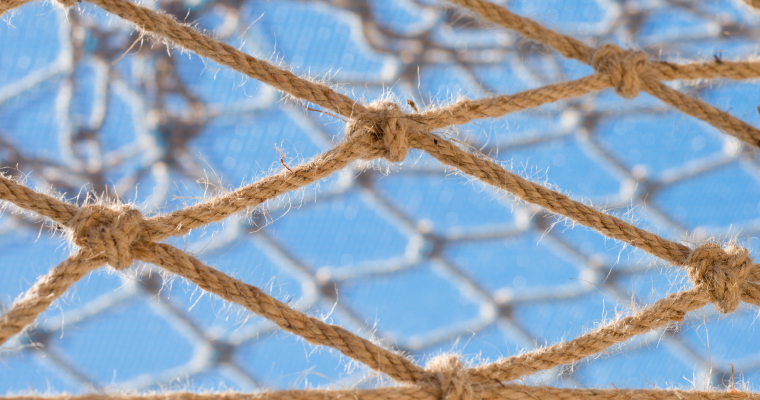
Alexandra Fields O'Neale's sound art installation, “Bound/Unbound” is in the courtyard of the Museum of Contemporary Art North Miami (MOCA). (Photo courtesy of MOCA)
She also respects the work of Miami-based photographer and multi- and mixed-media artist Onajide Shabaka, whose work focuses on daily rituals and observing the natural life. (“I admire his practice and the way he works.”)
Collado recently finished a one-year residency at the Center for Art and Public Exchange (CAPE), at the Mississippi Museum of Art where she hired a therapist and other artists to create a community project using social dance movements, ancestral and meditative mark making as a process of healing, regaining trust and intimacy after breast cancer.
While most of her work is on the serious side, Collado says with this installation, she wanted to tap into her inner child and create something joyful.
“We have to move forward,” she says. “We can bring our past with us, but to move forward we have to create joyful and meaningful cultural rituals and things we can celebrate – I really enjoy the shift to joy.”
Special Event: "Welcome to Paradise: Of Sound, Mind and Body – An Evening of Mindful Movement on Friday, March 29 from 6 to 8 p.m. An evening of mindful movement and sound activates the Welcome to Paradise installation, “Bound/Unbound” with gentle yoga movements under the guidance of the Kiyona Miah and Jasmine Mastin, founders of Black Yogis from South Florida, followed by an immersive sound performance led by sound artist, Kristen Soller. The event is free and open to the public. Please bring your own mat. To register, visit Museum of Contemporary Art Inc. (blackbaudhosting.com)
“Bound/Unbound” is on exhibition through June 2.
“For those who transcend in the wind/En los Ritmos de Oya/Nan ritm yo Oya” runs through June 16. Running through March 17 are “Ancient Future,” the first solo exhibition of Jamea Richmond-Edwards, and “Por América,” the captivating retrospective of Juan Francisco Elso. MOCA is located at Joan Lehman Building, 770 NE 125th Street, North Miami. The outdoor exibitions are free. Call (305) 893-6211 for information. The Museum is closed on Monday and Tuesday. Hours are 10 a.m. to 5 p.m. every day, except Wednesday, hours are noon to 7 p.m. The Museum is free for members and children under 12. Seniors and students are $5. General admission is $10.




